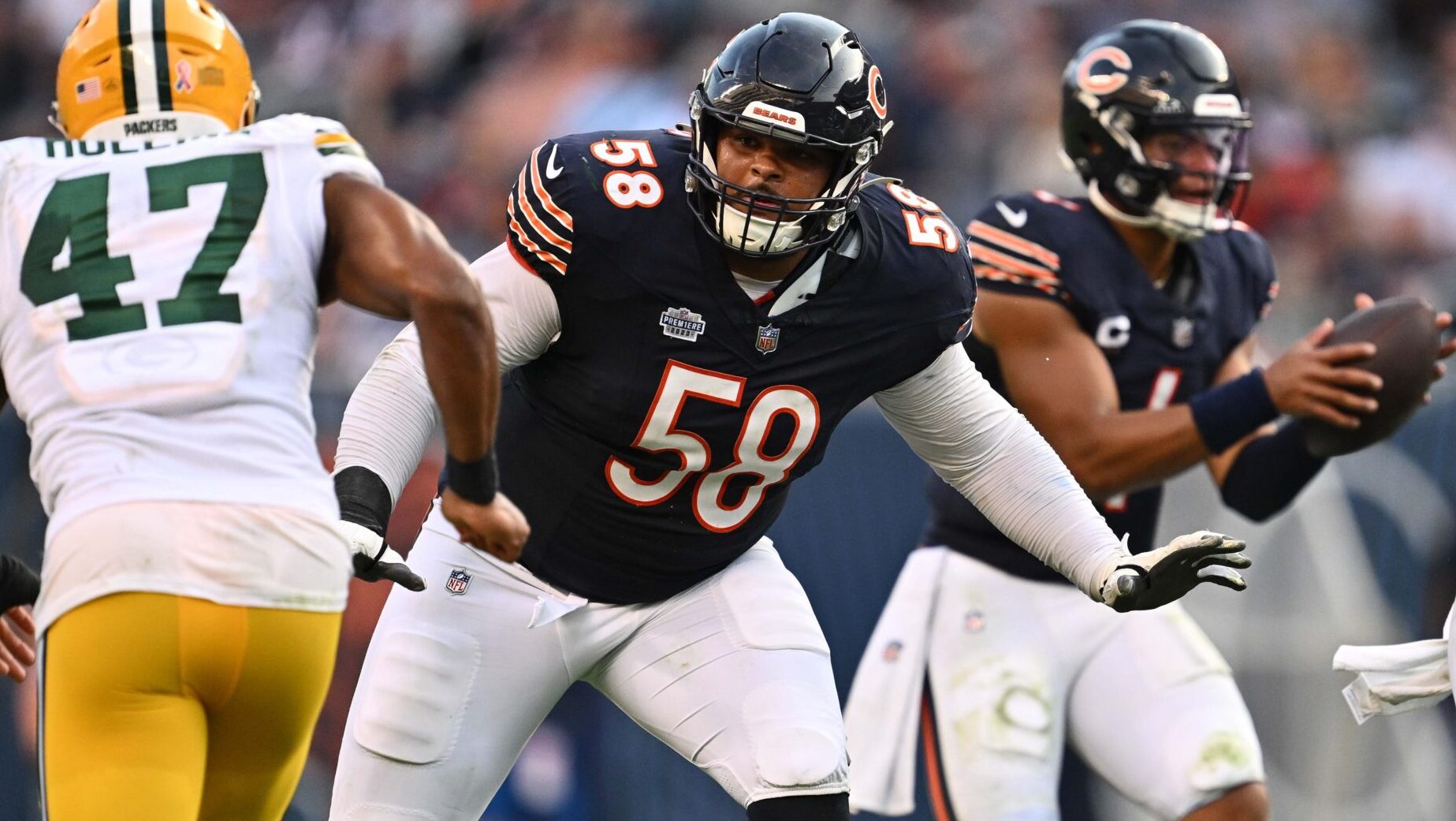Breakdowns
3/28/22
8 min read
How is Risk Calculated in NFL Player Acquisition?

In the NFL, there are two main resources you can allocate to acquire players: salary cap dollars and draft picks. Both are finite, meaning that every team starts with the same salary cap and same number of draft picks. As we touched on earlier this week, the decision to draft, trade for, or sign a player involves weighing the cost against the expected benefit. Trevor Lawrence was drafted first overall despite the cost of the best draft selection because the Jaguars anticipated his ability to be more valuable to the team than the next-best player available.
Sometimes these cost-benefit analyses can get especially complex. To the Raiders, the cost of getting Davante Adams was not only their top two picks in the draft but also a new five-year contract at a position-best $28M per year. Looking from a different perspective using the 2021 Draft, this transaction is like trading Caleb Farley and Dillon Radunz for the exclusive right to negotiate with Adams (who refused to play on the franchise tag), then giving him a market-setting deal.
Maybe it works out for Las Vegas, and maybe it doesn’t, but it demonstrates the general analysis that most teams use to make decisions. However, there’s an extra step in the process that hugely differs between front offices: the evaluation of risk.
Risk ties into the benefits side of the deal, as you’re attempting to predict their output over the life of their contract. Although it’s a broad term, risk is anything that prevents the player from reaching their full potential output: a new scheme and coaching staff, a new city, a new deal, legal issues and/or injuries can all get in the way.
We most frequently see the impact of risk by looking at the NFL Draft. Tyreek Hill “fell” to the fifth round due to a domestic assault conviction. Trey Smith was available in the sixth round because of his medical condition. Even Jerry Rice made it to the second half of the first round, behind receivers Al Toon and Eddie Brown, because he came from a small Mississippi Valley State program. Every player and every decision has some element of risk, so teams spend vast sums evaluating and reducing that risk in order to be as certain in their decisions as possible.
Every team treats these risks differently. Many teams would have refused to draft Tyreek Hill entirely based on exactly the same information that Kansas City had. Why did Kansas City choose the 165th overall pick to take this risk? It’s impossible to know without being in the room when the decision is being made. Based on experience, the 5th round is a good spot to draft a player who has compelling upside but material risk. If you hit on the player, that's great. If not, a player typically only has a 37% chance of starting multiple seasons in that part of the Draft anyway. Possibly, the Chiefs have joined a growing list of teams using data to predict the level of risk in a player.
For as difficult as they are to get information on, injuries are the best example to show how innovative teams can start to put a number on how risky a player is. Admittedly, the numbers themselves here are somewhat outdated, but the process shows how NFL teams can gain an advantage over their 31 competitors.
In 2008, a group led by Robert H. Brophy and Eric L. Chehab released a study called “Predictive Value of Orthopedic Evaluation and Injury History at the NFL Combine.” Though technical, this piece is especially valuable because it specifically worked with longtime New York Giants Head Athletic Trainer Ronnie Barnes. The team was able to get access to medical grades given to prospects from 1987 to 2000 at the NFL Combine and relate those grades to the performance of players on the field.
With a grading system of only three tiers (High Pass, Low Pass, and Failure), they were able to vastly differentiate between the percentage of players who ever played in the NFL, and how much they did so. For example, 58% of players with a grade of “High Pass” and 56% of players at “Low Pass” got on the field, but only 36% of “Failures” did. The High Passes who got on the field averaged careers of 71.0 games, compared to 62.2 games for Low Passes and 52.3 for Failures. This allowed the group to measure expected career length based directly on the medical evaluation – 41.5 games for High Passes, 34.2 games for Low Passes, and 19.0 games for Failures. When they added subjective pre-draft talent ratings to the mix, not to mention studies on specific injuries, these expected career lengths got even more distinct.
It’s obvious how much teams can do with this kind of information. If (hypothetically) a team gave Trey Smith a “Low Pass” medical grade, that changes their expectations about how he will perform on the field. He would average 62.2 games in his career, so is he talented enough to outperform the 71.0 games of the High Passes drafted around him? Nearly every NFL team uses a numbered scouting scale that ends up with a final “talent grade.” If Smith is expected to play 87.6% of the average prospect’s games, you can directly incorporate that with the talent grade to more accurately find an overall grade that accounts for injuries.
As a club is finalizing their decision on a player; risk is thoroughly evaluated. Psychologists categorize player personalities, Doctors evaluate health, and Security departments weigh in as well. But ultimately, a team is making a decision based on how they expect the player to play for them in their current scheme. Based on all the aforementioned factors, they must decide whether it is reasonable that the player will be successful and that the resources allocated to acquire that player are consistent with that expected performance.
The most notable recent example is the Deshaun Watson trade and extension executed by the Browns. Not only does Watson carry significant social and reputational risk, as evidenced by the significant amount of public backlash the team is facing, but he also carries an injury risk.
Watson had a broken hand, torn left ACL, and shoulder fracture in college alone. He tore his other ACL as an NFL rookie and sprained his back a few years later. Despite these multiple significant risks, Cleveland guaranteed him $230 million, the same as the guarantees recently given to Josh Allen, Dak Prescott, and Kirk Cousins combined. Given how far above the market this contract is, the Browns either ignored the risks in their valuation or truly believe Watson to be worth far more than any NFL player has ever been paid.
One of the most memorable times we dealt with a high risk was in the 2016 NFL Draft. Sitting at the 13th overall selection, the top player on our board was presumptive top pick Laremy Tunsil, so we were prepared to take the best defensive lineman or corner available. However, his infamous video was leaked and suddenly his risk was far higher than teams were prepared to withstand. With the pre-draft research we had done on Tunsil, we were comfortable in his character and did not consider the risk to be as concerning as some other teams. Of course, Tunsil became the standout player he is today.
Another such scenario was our 2009 trade for Braylon Edwards. We identified early in that season that we needed additional help at outside WR, and Edwards was a player we identified as a possible fit. With a background that included a significant knee injury and an altercation with teammate Charlie Frye, he carried a higher risk profile. He acquiring him also offered a significant potential reward as a Pro Bowler and third overall draft pick.
For several weeks we engaged with Cleveland HC Eric Mangini and GM George Kokinis, but they were steadfast in their demand for a second-round pick. As the trade deadline got closer and we went on a multi-game slide, we were heading towards meeting their demands when we got word that Edwards had been in an altercation in Cleveland. This event increased the risk associated with Edwards, so Coach Mangini called us and finally relented off the requested second-round pick, allowing us to acquire Edwards for a third, fifth, and a pair of rotational players. In his one-and-a-half seasons as a Jet, Edwards caught 88 passes for 1,445 yards and 11 TDs as a key part of two consecutive AFC Championship appearances.
These evaluations of risk dot every transaction in NFL history. The best NFL teams are systematic in their evaluations and negotiations in order to find the proper balance of risk and reward to best set up their organization for success.







